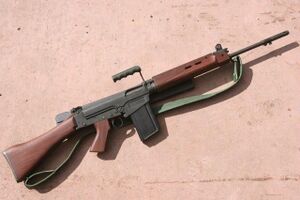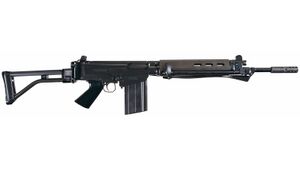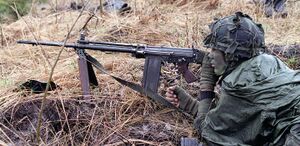IAR-38
| IAR-38 | |
|---|---|
 | |
| Type | Assault rifle |
| Place of origin | |
| Service history | |
| In service | 1952 - Present |
| Used by | |
| Production history | |
| Designer | Wilton-Nash Firearms Company |
| Designed | 1943 - 1949 |
| Manufacturer | Wilton-Nash Firearms Company |
| Variants | See Variants |
| Specifications | |
| Weight | 4.25 kg (9.4 lb) unloaded / 5.05 kg (11.1 lb) loaded |
| Length | Overall: 1090 mm (43 in) |
| Barrel length | 533 mm (21 in) |
| Cartridge | 7x43mm |
| Action | Gas-operated short-stroke piston, Tilting Block |
| Rate of fire | 700 RPM |
| Muzzle velocity | 740 m/s (2,430 ft/s) |
| Effective firing range | 400m |
| Feed system | 20 and 30 round box magazines |
| Sights | Aperture rear sight, post front sight |
The IAR-38 is a Trinovantan assault rifle designed by the Wilton-Nash Firearms Company. It is one of the first military service rifles in Pardes to use an intermediate cartridge, being chambered for the 7x43mm cartridge. It was the standard service rifle for Trinovantum from 1952 until it was replaced by the IAR-60 in the 1980s.
Development
The IAR-38 was initially conceptualized by Jonathan Webb in 1943. A veteran of the [CONFLICT], Jonathan Webb noted frequently the gap in performance between submachine guns and rifles in the varying terrain of Northern Kasaishima, with areas of built up jungle as well as open savanna and rolling hills. This terrain resulted in widely variable engagement ranges, where one type of weapon would have significant advantages over the other. In response to this experience, Webb attempted to design a “universal rifle” that would be effective both at close and long range engagements.
Initial prototypes made use of a heavily modified and lightened action derived from the IAM-15, using the 7.7x56mmR rifle cartridge. However, the lightened action proved too unreliable, and the powerful cartridge made the lightened weapon nearly uncontrollable in automatic fire. As pistol cartridges could not be made to produce enough power to be sufficiently effective at long ranges, Webb determined that an entirely new kind of cartridge would have to be made. After experimentation, Webb settled on a 7.7x38mm cartridge which used the projectiles from the older 7.7x56mmR cartridge. This cartridge, combined with an entirely new rifle of his own design, was pitched to several Trinovantan firearms companies.
Wilton-Nash showed interest in the design, and in 1947 purchased the patent and licensing rights to the rifle from Webb. Many iterative changes were made to the relatively crude prototype, but the most notable was the replacement of the 7.7x38mm cartridge with the Wilton-Nash designed 7x43mm cartridge, which improved the long-range performance of the rifle without significantly impacting the rifle’s controllability on automatic fire. In 1949, the rifle was proposed as a replacement to the IR-1. After comparative testing by the Trinovantan Armed Forces, the rifle was accepted as the IAR-38 in 1952.
Design Details
The IAR-38 is a gas-operated rifle using a short-stroke spring driven piston and a tilting breechlock locking system. A gas regulator is present near the front sight post, which allows for adjustment of the gas system to fine tune the weapon’s firing characteristics. The piston can be bypassed via the gas plug, allowing firing of rifle grenades and manual operation of the action. The rifle is magazine fed, with the standard milspec magazines being 20 round double-stacked magazines. The recoil spring is housed within the stock on all models of the IAR-38 except for the IACR-38, which moves the recoil spring into the receiver housing in order to mount a folding stock. This necessitates a different lower receiver, receiver cover, recoil spring, and bolt assembly from other models of the IAR-38. Most modernized variations of the IAR-38 design use the IACR-38 as a base to accommodate folding and aftermarket stocks. Both light and heavy barrels are manufactured for the IAR-38. The heavy barrel IAR-38s are generally equipped with a bipod and intended to be used in sustained suppressive fire.
The IAR-38 has lighter recoil when compared to its contemporary competitors, both in automatic and single-shot firing. This is primarily due to the use of the intermediate 7x43mm cartridge and the easily tuned gas system. However, the felt recoil when making use of automatic firing is considered harsher than most of the later intermediate caliber rifles that followed, even those that used the same cartridge.
Operational History
Variants
Military
- IAR-38 - Trinovantum Service Rifle
- IABR-38 - Heavy-Barrel Squad Automatic Weapon
- IACR-38 - Carbine, no carrying handle, folding stock
Civilian
- WN R50 - Civilian Market Semi-Automatic rifle
- WN R50A - Milspec rifle for civilian sale
- WN R50M - Modernized SAO WN52
Users
Current
 Temuair|
Temuair|
- Aisling Army - Some units remain in storage

